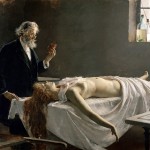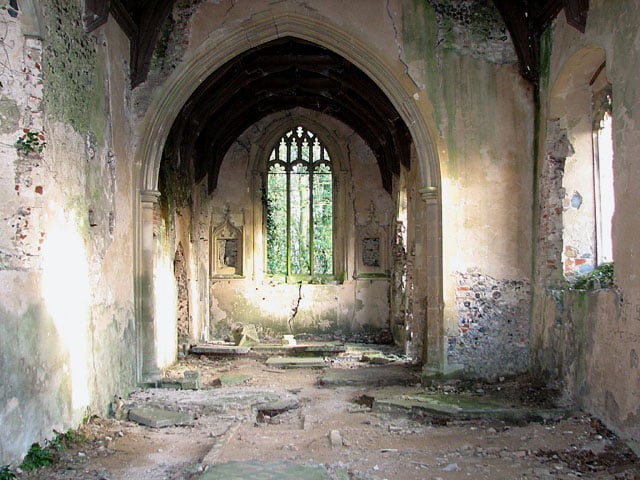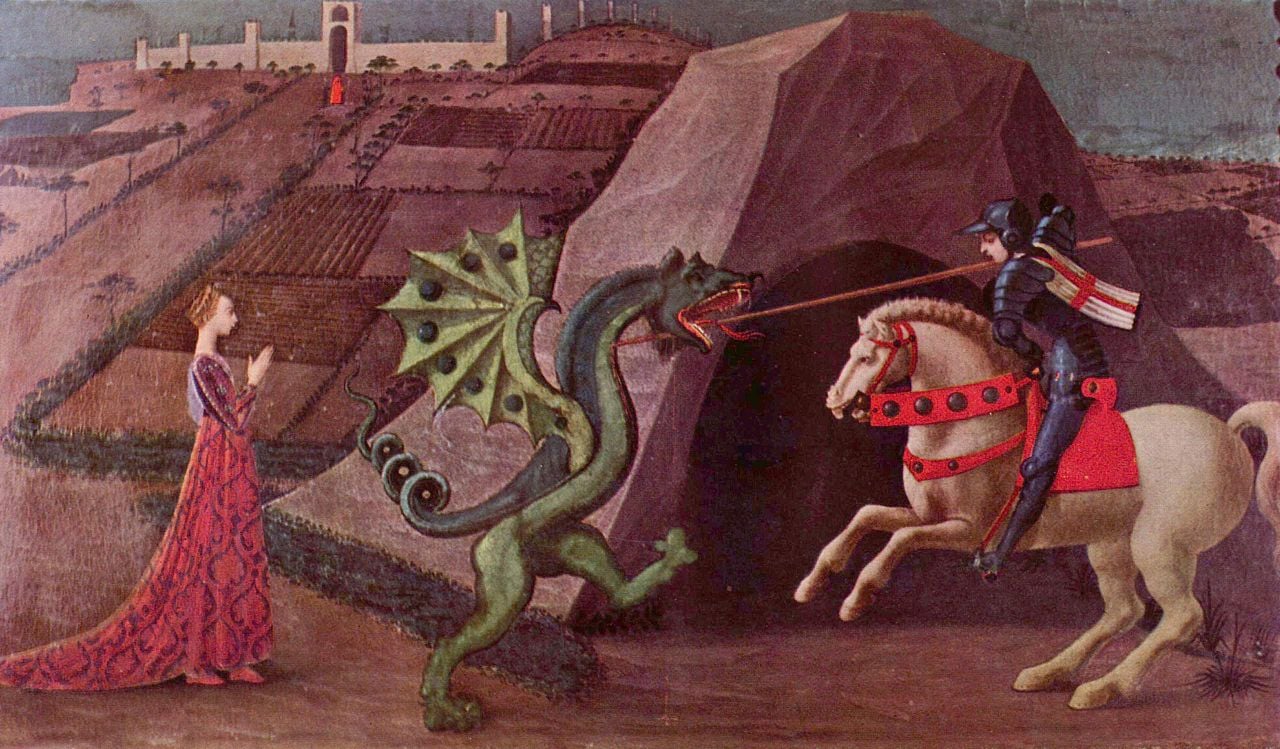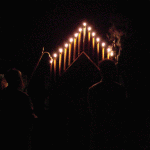
[Editor’s Note: Here’s a post by a Hillsdale student who was not in the TOB class but was inspired by the project nevertheless. It honors my favorite show, Mad Men, which aired its final season premiere on Easter Sunday. (No need to worry about spoilers.)]
The end of Lent has come. This season of fasting, prayer, and almsgiving is over, and with the celebration of Easter just beginning (it’s a season, not just a day!) a reflection on those sacrifices by which we better conform ourselves to Christ is needed. Some of us may have fasted from a certain thing (food, music, TV), others adopted a virtuous habit; but we all attempted improvement in our prayer life. Whatever we did, it was to better ourselves by purifying who we are, realizing our need for God’s mercy so that we may better imitate the loving sacrifice Christ made on the Cross. Every Easter Sunday, the liturgy reminds the Church how Christ makes man whole again–through the redeeming love hidden within the Paschal Mystery. When we fast during Lent, it is because we see the goodness in the love of Christ and the immense power of His radical love, and we long to imitate Him.
While Lent is the formal season of the Church for such imitation and conformation, in reality, we try to improve ourselves daily. We see friends, family members, even strangers who struggle to work out daily, eat more healthily, or go to daily Mass. We recognize that good, and perhaps attempt to imitate it. Maybe our chosen act is not the same, but it is typically influenced by the good decisions and virtuous acts of those around us–stranger or friend. That is a great thing. Inspired by those around us, we long to be better students, daughters, husbands, friends, etc.
Peggy Olson, the resident copywriter for Sterling Cooper, is no different. In AMC’s Mad Men, this formidable woman rose through the ranks from secretary to copy writer in a handful of episodes, sharpening her talent and honing her natural skill by imitating those around her, especially her proto-mentor and boss, Donald Draper.
Don Draper is a complicated, broken man. (A 20th century Russian inspired novel could be written about him and the brilliant actor who plays him, John Hamm. Alas, another story for another day!) Goodness can be glimpsed among the shards of his broken life; however, his sin need not overshadow his goodness. Peggy Olson, I believe, saw what made this man great–that goodness–and longed to be like him. Unfortunately, Peggy does not really know Don. She struggles to understand which of his actions reveals his goodness and which aids his sinful nature, one particular sin being Don’s inability or unwillingness to remain faithful to his wife, Betty.
In season three, episode two, which is titled “Love Among the Ruins,” Peggy is a full-time copy writer, slowly building her confidence and street cred as a working woman in the advertisement world and in the eyes of Don. Throughout the beginning of the episode (really the whole previous two seasons) Peggy observes, processes, and then acts in accordance with what will better her position in the office, usually by imitating Don.
In this episode, Peggy makes a conscious decision to model her personal life after her mentor’s. This faulty choice of Peggy’s becomes apparent when she decides to have a one-night stand with a college senior she met in the bar. The audience should realize that when Peggy models her life after a broken man, that imitation is destined for ruin. She leaves the boy’s apartment in the middle of the night with an awkward excuse. Emotions of fulfillment and power do not appear, but rather confusion and dissatisfaction emerge as she flees from this boy’s college dorm room. These scenes of sexual escapades are Don’s habitual place of sin; and they smother the sparks of goodness in his broken soul. The light is not completely out, but it is dimmed.
Minutes later in the episode, we see Don perform a heroic, loving action towards his wife, which contrasts with Peggy’s poor choice. Betty’s father, Gene, has fallen ill and her brother is unwilling to take him in. Don (not in the most tactful way) demands that Andrew, Betty’s brother, leave their father in Don’s home so that the Drapers can financially and physically care for him. Don does not love Betty’s father, nor does Gene particularly like him. But Don does takes him in anyway, performing a sacrificial act of love for his wife.
Don’s life reveals a complicated truth of Scripture: we are all sinners, but we’re called to be saints; and we’re all beggars before Christ, but we are also invited to be His adopted children. St. John Paul II in his Theology of the Body addresses this as he explains some consequences of the Fall:
Shame has a double meaning. It indicates the threat to the value and at the same time preserves this value interiorly. The human heart, from the moment when the lust of the body was born in it, also keeps shame within itself. This fact indicates that it is possible and necessary to appeal to the heart when it is a question of guaranteeing those values from which lust takes away their original and full dimension. If we keep that in mind, we can understand better why Christ, speaking of lust, appeals to the human “heart”. (28 May 1980)
St. John Paul II reminds us that Christ does not do away with man’s heart, but rather redeems lust by transforming it into the love for which it was created. Mankind’s original goodness was shattered, but remained intact inside of him–like glass in a picture frame. While refracted light struggles to pass through the cracks of the broken glass, it still illuminates the image. The glass itself never fell out, just as our soul remained intact after the Fall: it remains broken but salvagable. It is that same glass which must be used to make a better reflection. In the Middle Ages, stained-glass windows, which are shattered pieces of glass placed together, became the showpieces on which the life of Christ, the Saints, and our beloved Mother, the Virgin Mary, appeared for the faithful. These stories were told not in words but images, through shattered pieces of a former whole purposefully placed together again to tell the story of Christ and His Church.
Peggy sees Don’s goodness in his broken existence. She wants to be like him, just like we long to be like the saints and imitate their goodness. But because we like Peggy are fallen sinners, we do not know how to see that real goodness, and subsequently submit ourselves to the vices and sins which we convince ourselves are good.
Don’s good and loving act towards Betty reminds us that broken things can be beautiful. Why do millions of people visit the Coliseum, the Parthenon, or Tintern Abbey? Because these ruins remind us of the whole, of the beauty and majesty that used to exist there. These ruins would not attract the hearts, souls, and minds of men if they did not point to something better and something higher than what merely attracts the eye. Don is such a “ruin”. We must look harder and search further for the goodness that lies right before us in order to see the sinner and the saint in every man who appears before us. This is accomplished through love, a purifying charity that reflects the act of Christ on the Cross. Love is the bonding facet which ties us to Christ and teaches us how to imitate His sacrificial love that silently speaks from the Cross. Only by being Love’s pupil can we become whole again, like the stained-glass window illuminating the picture of Christ’s love. With purified sight and heart, we can realize that “love is best,” as Robert Browning reminds us in his poem “Love Among the Ruins” which lends its name to the episode and this blog. He describes in his final stanza that love which heals the brokenness in all of us. This love transforms ruins into beloved places, just as it transforms sinners into saints.
***
Katie Summa is a History Major at Hillsdale College, graduating this May. A native of North Carolina and a lover of Thomas Aquinas, she finds Christ in the beauty of philosophy, literature, art, and people.













